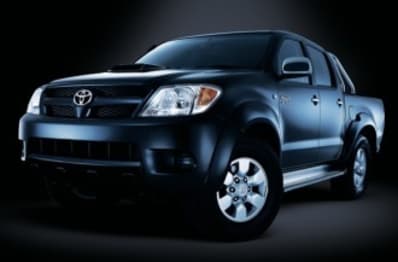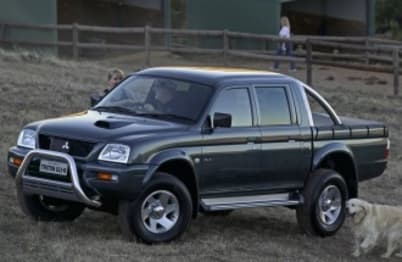
Used Toyota HiLux review: 2005-2015
- Toyota HiLux
- Toyota HiLux 2018
- Toyota HiLux 2009
- Toyota HiLux 2005
- Toyota HiLux 2006
- Toyota HiLux 2007
- Toyota HiLux 2008
- Toyota HiLux 2010
- Toyota HiLux 2012
- Toyota HiLux 2013
- Toyota HiLux 2011
- Toyota HiLux 2014
- Toyota HiLux 2015
- Toyota HiLux Reviews
- Toyota Reviews
- Toyota Commercial Range
- Toyota Ute Range
- Commercial
- Ute
- Toyota
- Used Car Reviews
- Family Cars
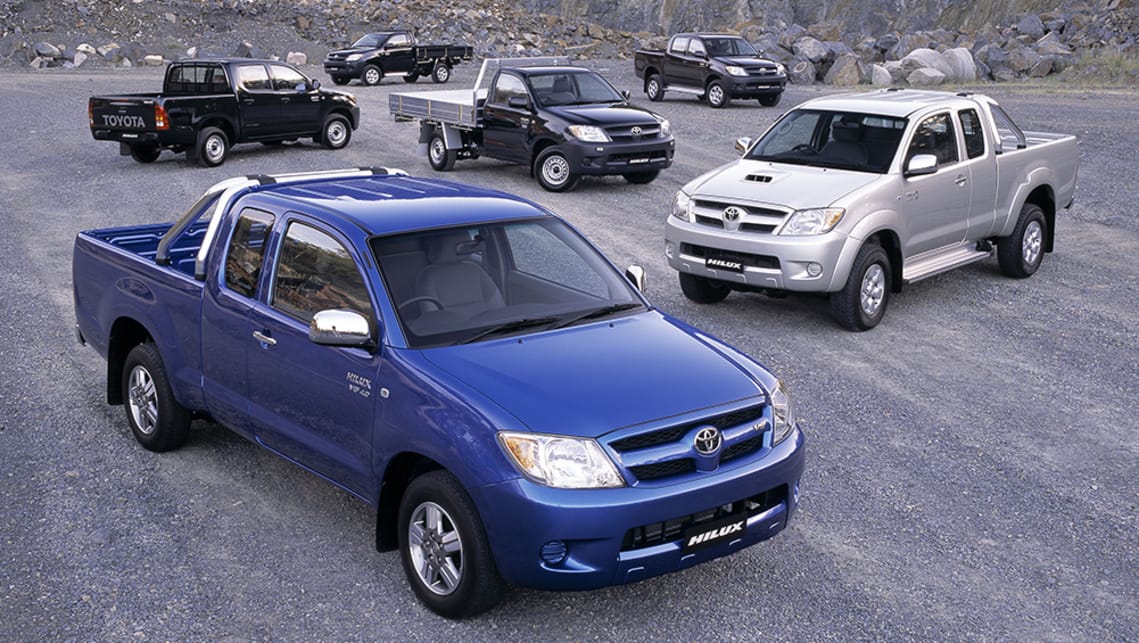
What we like
- Durable
- Reliable
- Versatile
What we don't
- problems with 1KD-FTV turbo diesel engine
- Used models can be damaged from work
What we like
- Durable
- Reliable
- Versatile
What we don't
- problems with 1KD-FTV turbo diesel engine
- Used models can be damaged from work
The news that the Toyota HiLux had become Australia's top-selling vehicle confirmed that Australians were looking beyond traditional sedans and hatches and seeking an all-around vehicle that could perform a number of roles.
Utes were no longer just working class vehicles that did the hard yards on the job site during the week, and then left sitting idle on weekends. They had to perform on weekdays and on weekends.
In its high-end dual-cab configuration the HiLux SR5 could be a family car, but at the same time it could haul a tradie's tools, tow a caravan on the trip of a lifetime, or simply look cool cruising to the beach.
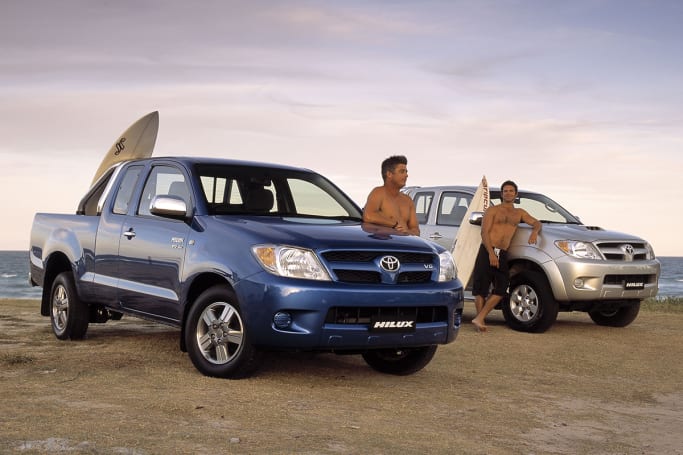
Models
Toyota covered all bases by offering a range of cab-chassis and pick-ups with a variety of body styles in two and four-wheel drive configurations, and the choice of petrol- and turbo-diesel engines.
The HiLux that was released in 2005 had more cabin space, carried heavier payloads, performed better and consumed less fuel. It also boasted improved safety, comfort, refinement, and was better equipped.

Underneath lay a conventional ladder chassis with coil spring independent front suspension for ride comfort and semi-elliptic leaf spring rear suspension to carry a load.
At the working class end of the range was the rear-wheel drive Workmate, which was offered as a cab-chassis with a single-cab or a dual-cab pickup. It had a 2.7-litre four-cylinder petrol engine with more horsepower than its predecessor and a five-speed manual gearbox.
Given its place at the bottom of the range its list of standard features was relatively short, consisting of dual front airbags, seat belt pretensioners, an immobiliser, power steering, and a radio/CD player.
Air conditioning was available as an extra-cost option, but it wasn't climate control.

The mid-range SR was available in rear-wheel drive and four-wheel drive as a cab-chassis or pick-up, with a choice of single-cab, extended-cab or dual-cab bodies.
There was a choice of 4.0-litre V6 petrol engine or 3.0-litre four-cylinder turbo-diesel, and five-speed manual gearbox or five-speed automatic transmission.
Standard features were dual front airbags, seat belt pretensioners, remote central locking, radio/CD player, MP3 compatibility, immobiliser, cruise control, variable intermittent wipers, power windows, and cloth trim.
Options consisted of air conditioning and ABS anti-lock brakes.
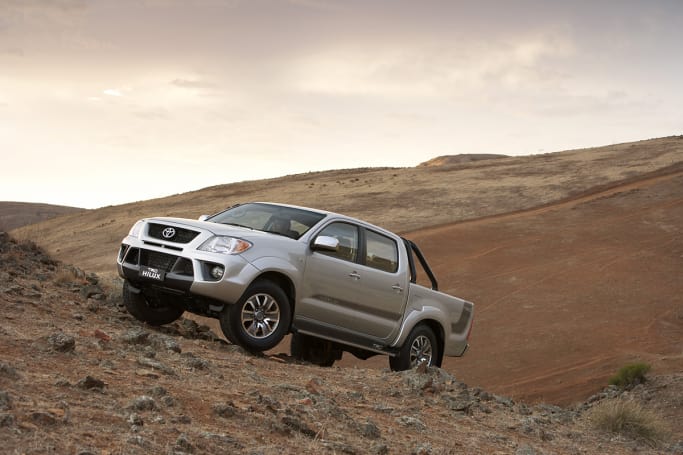
At the top of the range was the SR5 pick-up, which was offered in rear-wheel drive and four-wheel drive form, with extended-cab or dual-cab bodies, V6 petrol or four-cylinder turbo-diesel engines, and manual gearbox or automatic transmission.
Befitting its lofty position the SR5 had a long list of standard goodies, including 15-inch alloy wheels, chrome door handles and rear view mirrors, side steps, body colour bumpers and grille, guard flares, alloy sports bar, rear step bumper, front fog lamps, air conditioning, radio/CD stacker with four speakers, MP3 compatibility, sports instruments, trip computer, remote central locking, power windows and mirrors, leather steering wheel, cloth trim and carpeted floor.
Safety features consisted of dual front airbags, seat belt pretensioners, and ABS anti-lock brakes.

A makeover in 2011 brought 17-inch alloy wheels, sat nav, air conditioning with climate control, automatic headlights, multi-function steering wheel, and power mirrors with indicators.
At the same time safety features were expanded to include side front airbags, head airbags, electronic stability control, traction control, electronic brakeforce distribution, and emergency brake assistance.
Bluetooth was available on the SR5 from 2009, allowing the connection of an iPhone or Android device.
A reversing camera was fitted to the SR5, but there were no parking sensors, or a park assist system.
There was no touch screen or sunroof offered, but the spare tyre was full-sized.
Cabin
The HiLux cabin was a pleasant place to be with good head, leg and elbowroom for everyone, whether in the front seats or in the back.
Hardwearing cloth covered all seats, while workmanlike rubber was used on the floor in all but the SR5, which boasted carpet.

There was no lacking in features with a tilt-adjustable steering wheel, cupholders, centre console, and a multifunction steering wheel from 2011.
Fitting a baby car seat was problematic in the HiLux. It wasn't possible in the single-cab or extended-cab models, and with a lap belt in the centre rear seat it was only possible to fit one in the outer rear seats, which had lap/sash seat belts, but that was not the safest place for a baby to travel.
ISOFIX mounting points are not fitted.
Engine
The Workmate had an updated 2.7-litre four-cylinder petrol engine; it now put out more horsepower and torque. At its peaks it produced 118kW/241Nm.
It was initially linked to a five-speed manual gearbox, but a four-speed automatic transmission was offered from the 2011 update.
On the road the four-cylinder engine performed quite well, it was flexible and pulled steadily through the rev range.
When it became available the four-speed automatic was a drain on performance, the absence of a fifth gear was noticeable.
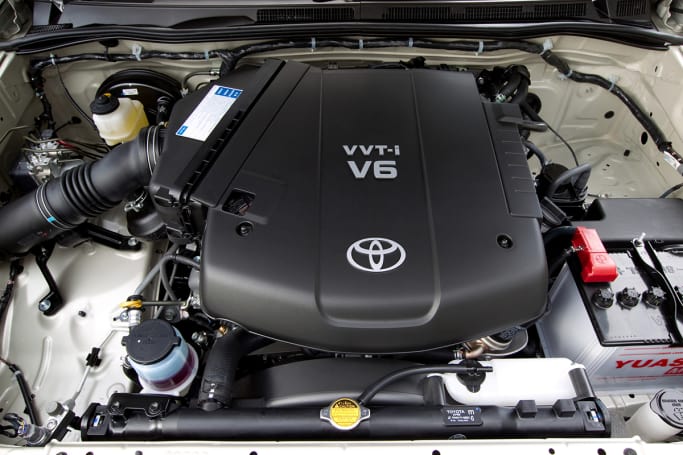
Without doubt the 4.0-litre petrol V6 was the performance king of the range with an impressive 175kW/376Nm at its peaks.
It was silky smooth, had all the punch you could possibly want on the road, but the stunning performance did come at a cost, as the big V6 sucked unleaded petrol like there was no tomorrow.
Driven with a light foot it could return reasonable fuel economy, and 10.0L/100 km wasn't out of the question on the highway.
Both petrol engines used 91-octane regular unleaded.
The answer to the pump blues was the 3.0-litre four-cylinder common-rail turbo-diesel, which boasted impressive performance with 120kW/343Nm, while delivering much better fuel economy.
Both the V6 and the turbo-diesel could be coupled with manual or automatic transmissions, and both were available with rear two-wheel drive or four-wheel drive.
Driving
On the road the HiLux was a decent driver; it handled well and performed strongly.
The four-cylinder could struggle at times when loaded to the hilt, but in most situations it pulled manfully, and showed ample zip.
But it was the V6 that put a smile on your face if you wanted performance. Step on the gas and it responded enthusiastically, although sadly the fuel consumption climbed when you did that.

The turbo-diesel was the best of both worlds, with impressive performance, good towing capacity, and good fuel economy.
Being primarily a working vehicle expected to carry a load, with a combination of light truck tyres and high inflation pressures, the ride was relatively firm, but not so much to make it uncomfortable.
Wind and road noise were quite low for a vehicle of its type.
The HiLux has a turning circle of 12.2 metres, but it is still easily manoeuvred around the tight confines of town or a work site.
The HiLux was capable of towing up to 2500 kg depending on the model.
Safety
Utes like the HiLux have traditionally lagged behind their sedan counterparts when it came to safety, but with their growing popularity with families carmakers have had to bring them into line with regular passenger cars.
With a full array of airbags, front, side and head, plus a full complement of active safety features like ABS, electronic brakeforce distribution, emergency brake assist, and electronic stability control, the HiLux was well equipped when it came to safety.
When all of that gear was fitted ANCAP rated it at five stars.
Any issues?
Toyota has long boasted that the HiLux was unbreakable; its owners praise its reliability.
Generally the HiLux is reliable and durable, as owners often say. There are many that have accumulated many hundreds of thousands of kilometres with few repairs needed other than the replacement of regular wear and tear items like brakes, clutches, tyres, exhausts etc.
One potentially very serious problem affected the 1KD-FTV turbo-diesel engine used in the HiLux relating to the fuel-injector seals.
The seals are prone to leaking letting blow-by gases enter the engine oil stream, which can turn the oil to carbon and eventually clog the oil pickup in the sump and in some cases starve the engine of oil. The worst-case scenario is engine seizure.
Such is the seriousness of the issue that Toyota recalled HiLuxes in the UK, while in New Zealand the company introduced a requirement to change the injector seals every 45,000km.

Owners of HiLuxes with the 1KD-FTV engine would be well advised to have their dealers inspect the oil pickup to check on carbon build-up and have it cleaned if carbon is found. It's possible to inspect the oil pickup by inserting a probe through the oil drain plug without removing the sump. It would also be prudent to change the injector oil seals.
In 2010 Toyota recalled 4WD models to check for a possible failure of the tailshaft support bracket. Ensure any vehicle you're thinking of buying has been checked and cleared of this problem.
With the potential to be used as a tradie's work hack, or off-road it's important to thoroughly inspect any HiLux being considered for purchase.
It's particularly important to check underneath any 4WD model for damage. We've heard of CV joint seals splitting, so make these one of your checks.
Check for regular servicing and, particularly in light of the potential issues with the diesel, check for evidence of regular oil changes.
Toyota was the first to introduce capped price servicing, and it applies to the HiLux, as such the service costs are quite reasonable.
Servicing is recommended every six months/10,000 km, and the warranty covered the vehicle for three years/100,000km.
The petrol engines have timing chains so there's no call for regular replacement.
MORE: If anything crops up, you'll probably find it on our Toyota HiLux problems page
Owners view
Thomas Eldridge: 13 years after we bought our SR5 it's still going strong. There have been a few minor issues, but overall it's been great.
Trevor Bourne: I've owned my SR since 2012. I've found it comfortable around town or on long runs, the seats are good, and there is plenty of cabin storage. The turbo-diesel engine has ample power and will tow heavy loads with ease. In 270,000km all I've had to replace are the battery and the clutch.
Ken Cooper: I bought my 2007 SR5 new. The engine was destroyed after 170,000 km when sludge build-up was caused by the injector seals leaking. I expected more from Toyota.
Mick McConnell: My 2007 SR V6 has done over 600,000km and is still going like new. The V6 is great. The clutch is noisy, but it's been like that for five years now.
Rivals
Nissan Navara
Lost in the new age pack, but it's a worthy contender.
3 stars.
Mitsubishi Triton
Good all-rounder, but can struggle when worked at the extreme.
3 stars.
Ford Ranger
Reliable, comfortable and economical new-age worker that happily does double-duty at family time.
3.5 stars.
Verdict
More refined, more comfortable, but still a worker at heart.
Rating
3.5 stars.
Pricing
| Year | Price From | Price To |
|---|---|---|
| 2015 | $14,410 | $52,360 |
| 2014 | $13,420 | $44,220 |
| 2013 | $11,000 | $39,710 |
| 2012 | $10,450 | $35,970 |
| 2011 | $6,820 | $33,000 |
| 2010 | $6,160 | $28,710 |
| 2009 | $5,830 | $28,050 |
| 2008 | $4,950 | $27,720 |
| 2007 | $4,840 | $25,080 |
| 2006 | $4,620 | $23,320 |
| 2005 | $3,410 | $20,570 |
Pricing guides
Range and Specs
| Vehicle | Specs | Price* | |
|---|---|---|---|
| Workmate | 2.7L, ULP, 5 SP MAN | $3,960 – 5,830 | 2005 Toyota HiLux 2005 Workmate Pricing and Specs |
| (base) | 3.0L, Diesel, 5 SP MAN | $4,180 – 6,160 | 2005 Toyota HiLux 2005 (base) Pricing and Specs |
| (4X4) | 3.4L, ULP, 5 SP MAN | $4,180 – 6,160 | 2005 Toyota HiLux 2005 (4X4) Pricing and Specs |
| SR | 4.0L, ULP, 5 SP MAN | $6,050 – 8,580 | 2005 Toyota HiLux 2005 SR Pricing and Specs |
Other cars to consider
$5,950
Lowest price, based on 95 car listings in the last 6 months




